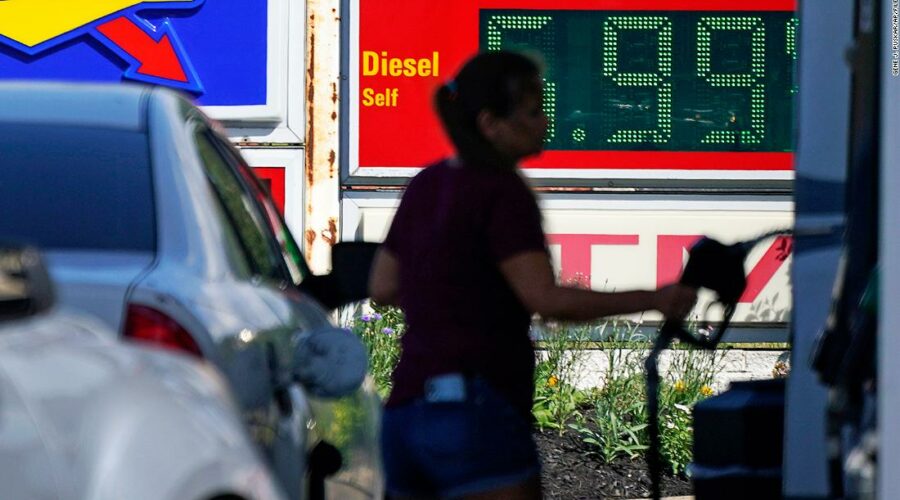Here's why a better than expected CPI report may not affect Fed's plan
New York (CNN Business)Prices in the US stayed the same last month. That’s a cause for celebration: it’s the first time they haven’t gone up since November 2020.
It could also mean that the Fed’s efforts to curb inflation are finally working and that a soft landing, where inflation is limited without toppling the economy into recession, is feasible.
I’ll give you a minute to put on your party hats.
Now, it’s time for the bad news. And there’s quite a bit of it.
First off, the only reason prices didn’t rise overall is because of the falling cost of energy. Everything else went up.
The cost of gas in the US has fallen for nearly two months straight and is down by about 67 cents in the last month alone. Oil has come down to around $90 a barrel after spiking above $120 a barrel in June.
See here: The average price of a gallon of regular gas fell below $4 on Thursday for the first time since March.
We’re all happy to get a break at the pump. But inflation excluding food and energy prices is still very, very high compared to a year ago. Randall Kroszner, former governor at the Federal Reserve, told CNN that while inflation has likely peaked, it will take at least a year before inflation returns to the 2% level targeted by the Fed.
“Core inflation is still very disturbing for the Fed, dramatically above where the Fed wants it to be,” said Kroszner, now a professor at the University of Chicago Booth School of Business. “It’s too early to give the victory signal because you really have to see core inflation come down. This is one report.”
Meanwhile, there’s no guarantee energy prices will keep declining. The Federal Reserve, the central bank tasked with taming inflation in the United States, will be the first to admit that it has little control over energy costs.
The ongoing war in Ukraine has made prices particularly sensitive to disruptions. Hurricane season is also about to begin, which could drive prices higher.
And we’re not getting breaks elsewhere either. Food prices rose by another 1.1% last month and electricity costs were 1.6% higher, not great for those trying to make it through this seemingly never-ending heatwave. Housing prices were also on the rise, in spite of recent data that shows home sales are cooling.
So while stocks shot up on the headline news — that the consumer price index rose at a slower pace from a year ago, coming in under analysts’ expectations — things aren’t quite as promising when we take a peek under the hood.
Producer price data for July due later Thursday will be watched closely for further clues.
About those food prices
We know food prices rose by another 1.1% last month, but it’s hard to understand why they aren’t coming down as fuel costs fall. After all, transportation accounts for a big chunk of what you pay at the grocery store.
Over the last 12 months, grocery prices soared 13.1% — the largest annual increase since the year ending in March 1979, the Bureau of Labor Statistics said Wednesday.
So what gives? A number of outside factors have contributed to the rise in food costs, reports my colleague Danielle Wiener-Bronner: A deadly avian flu has meant fewer eggs in the United States, a severe drought in Brazil slashed coffee crops and the war in Ukraine led to a spike in wheat prices in the spring.
The US can’t control these headwinds, and so the price of food is largely out of the Fed’s control. The Fed believes that “food and energy are influenced by global commodity prices in a way that tells them, ‘Hey, these items aren’t really directly under your control,'” noted Michael Gapen, head of US economics at Bank of America Global Research.
There are some ways they can bring prices down: Labor and packaging costs have also been high and those tend to get passed on to your bill at the grocery store.
Read more here.
I’m not a doctor, I just play one on TikTok
Hospital nurses, looking to rightfully relieve some stress during the height of the Covid-19 pandemic, coordinated and filmed dances that went viral on social media platform TikTok.
Now, TikTok’s parent company, Bytedance, is looking to enter the emergency care industry through another door. The company has reportedly paid $1.5 billion to acquire Amcare Healthcare, which runs a group of children’s and women’s hospitals across China.
It’s strange that a company whose expertise is in going viral would pivot into fighting infections but Bytedance is not the first tech giant to dabble in healthcare. Alibaba (BABA) and JD.com (JD) run online pharmacies and Amazon announced in July that it would pay $3.9 billion to acquire One Medical.
Up next
OPEC monthly report; US Producer Price Index for July; Earnings from Utz Brands, Warby Parker and Wheels Up.
On Friday: UK GDP; University of Michigan consumer sentiment survey.
Source: Read Full Article

